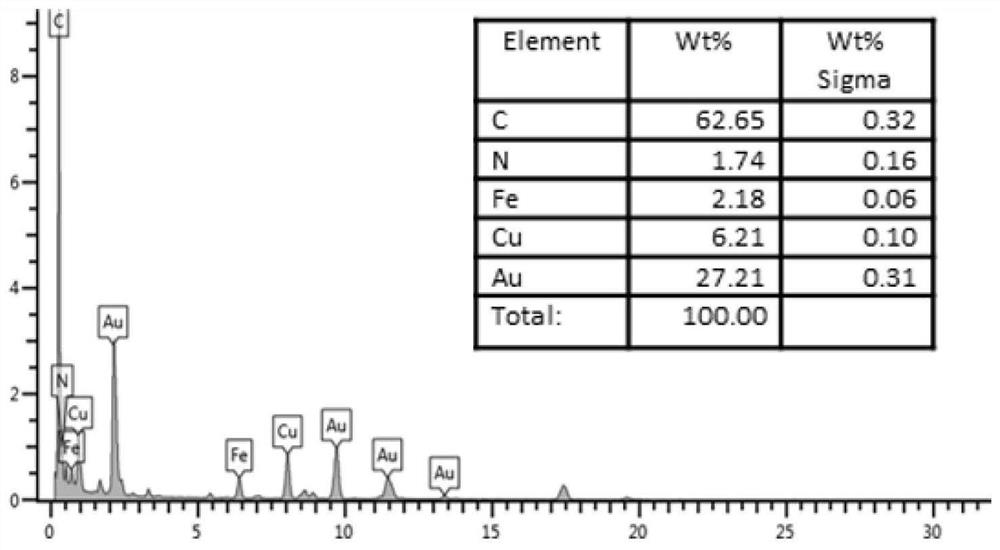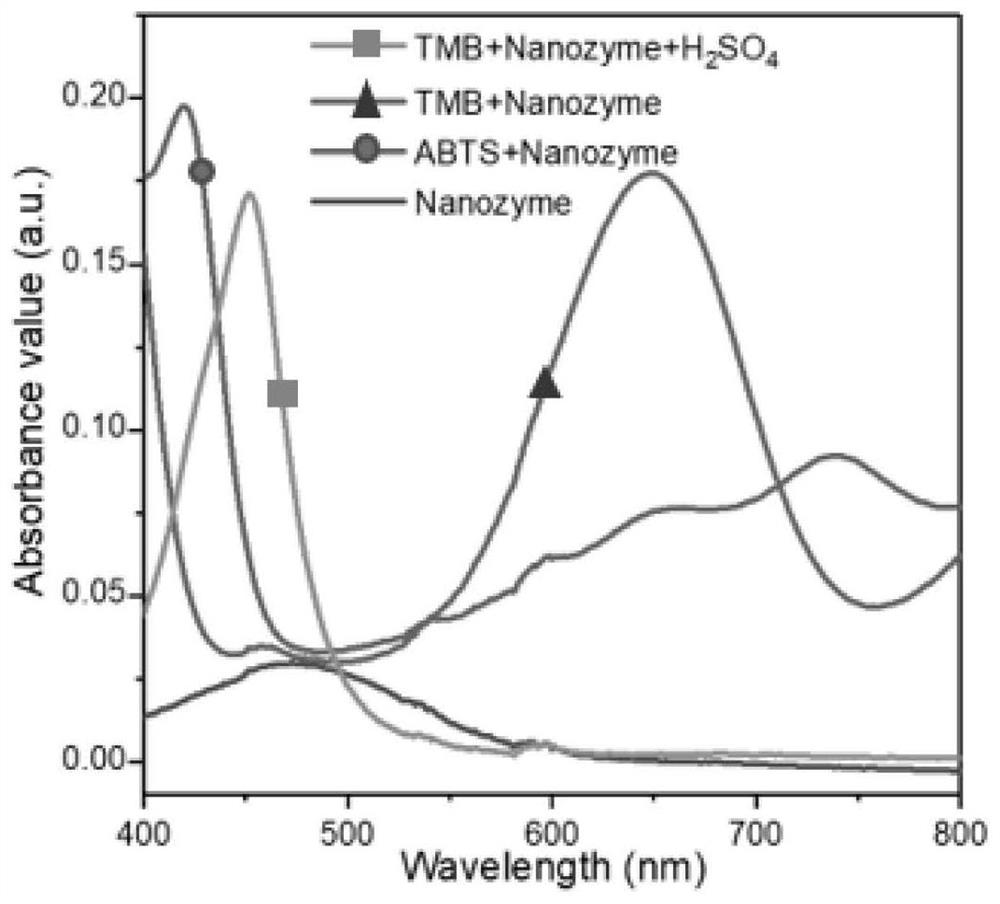A kind of nano enzyme and its preparation method for the detection of food antioxidant activity
A technology of antioxidant activity and nanozyme, applied in chemical instruments and methods, measurement of color/spectral characteristics, material analysis by observing the influence of chemical indicators, etc., can solve the limitation of large-scale application of ABTS method and cumbersome purification methods , Enzyme denaturation and other problems, to achieve excellent peroxidase-like activity, good practical application prospects, and good dispersibility
- Summary
- Abstract
- Description
- Claims
- Application Information
AI Technical Summary
Problems solved by technology
Method used
Image
Examples
Embodiment 1A
[0034] The synthesis of embodiment 1Au@Cu-HCF nanozyme
[0035] Dissolve 18.4 mg of potassium hexacyanoferrate and 0.15 g of citric acid in 10 mL of deionized water, and mix well. Then, inject 0.2 μL of sodium tetrachloroaurate (III) (1 mg) under vigorous stirring, continue stirring for 2 min, and add anhydrous copper sulfate solution (4 mL, 5 mg / mL) dropwise to the above mixture until it becomes Wine red, Au@Cu-HCF nanozyme solution is obtained, the nanozyme solution is centrifuged at 17000 rpm for 15 minutes, separated to obtain Au@Cu-HCF nanozyme.
[0036]Gold-doped nanozyme particles were prepared by a one-step self-assembly method. Transmission electron microscope (TEM) analysis showed that the morphology of Au@Cu-HCF nanozyme particles was spherical with a diameter of about 15 nm ( figure 1 ). Energy dispersive X-ray spectroscopy results showed that the Au@Cu-HCF nanozyme was composed of Cu, Au, Fe, N and C ( figure 2 ).
Embodiment 2
[0037] Example 2 Preparation of PEG-SH modified Au@Cu-HCF nanozyme
[0038] After the wine red Au@Cu-HCF nanozyme solution prepared in Example 1 was continuously stirred for 12 hours under the condition of avoiding light, 50 mg COOH-PEG-SH was added, and the stirring was continued for 12 hours. After centrifugation for 15 minutes, the PEG-SH modified Au@Cu-HCF nanozyme was obtained.
[0039] In this embodiment, by utilizing the strong interaction between gold and sulfur, COOH-PEG-SH is used to coat nanoparticles, which are modified with PEG-SH, so as to further improve the stability and biocompatibility of nanoparticles.
Embodiment 3A
[0040] Example 3 Determination of Au@Cu-HCF Nanozyme Peroxidase Activity
[0041] Take 40 μL of the Au@Cu-HCF nanozyme solution prepared in Example 1, mix it with 40 μL of deionized water and add 100 μL of TMB buffer (TMB buffer A+B, buffer A: take 8.2 g of anhydrous sodium acetate, 2.5g of β-cyclodextrin and 0.4g of urea hydrogen peroxide were dissolved in 1L of water; buffer B: 100mg of TMB was dissolved in 10mL of DMSO) for reaction, and 100μL of H 2 SO 4 Terminate the reaction, and record the UV-Vis absorption spectrum of the TMB system in the range of 400nm-800nm with a UV-Vis spectrophotometer.
[0042] Mix 50 μL of the Au@Cu-HCF nanozyme solution prepared in Example 1 with 50 μL of deionized water, and then add 50 μL of ABTS buffer (containing 4 mL of PBS, 200 μL of 3% H 2 o 2 and 10 mg ABTS) for color development, and after reacting for 10 min, record the UV-Vis absorption spectrum of the ABTS system in the range of 400nm-800nm with a UV-Vis spectrophotometer. ...
PUM
| Property | Measurement | Unit |
|---|---|---|
| diameter | aaaaa | aaaaa |
Abstract
Description
Claims
Application Information
 Login to View More
Login to View More - R&D
- Intellectual Property
- Life Sciences
- Materials
- Tech Scout
- Unparalleled Data Quality
- Higher Quality Content
- 60% Fewer Hallucinations
Browse by: Latest US Patents, China's latest patents, Technical Efficacy Thesaurus, Application Domain, Technology Topic, Popular Technical Reports.
© 2025 PatSnap. All rights reserved.Legal|Privacy policy|Modern Slavery Act Transparency Statement|Sitemap|About US| Contact US: help@patsnap.com



